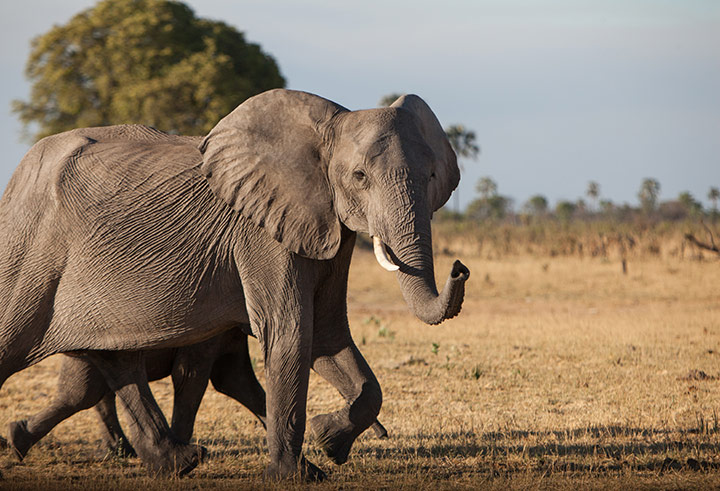On a safari in Hwange, our columnist discovers the dangers of walking behind a disconsolate Zimbo.
Also read: What not to do with a turtle hatchling

Elephants in Hwange National Park. Image by Chris Davies.
‘Are you sure we’re not getting too close?’ I asked.
‘It’s all right,’ said Gary.
He seemed distracted. ‘The wind’s in the other direction.’
I gave my wife an encouraging look. See? The wind’s in the other direction. I don’t think she was entirely persuaded.
We were in the north-west of Zimbabwe, in Hwange National Park. Before we’d arrived I was unsure what we’d find. You hear lots of scare stories about Zimbabwe. The place is in ruins! Nothing but poaching! Would there even be any elephants left? There were plenty of elephants left. The place was lousy with elephants. There were elephants everywhere, and Gary the guide was leading us on foot right up to them.
If my wife hadn’t been there, I’d have felt more nervous: it makes me braver when there’s someone more afraid than me. Besides, Gary does this every day. He does this for a living. He knows what he’s doing, right?
Gary bent over a little and motioned to us to do the same. I wasn’t exactly sure how reducing our height by thirty centimetres might render us invisible to elephants. There were 20 or 30 or 40 of them, young bulls and cows and some young calves, idling beside the waterhole, tossing sand in the last orange light of the day. I’d heard you shouldn’t get too close too moms and their kids, especially on foot. I’d asked Gary about this, and he’d winked and said, ‘Hey, do I come to where you work and tell you how to punctuate?’
I had faith in Gary, but two things bothered me. The first was that he was a white Zimbabwean, and everyone knows white Zimbos are crazy. White Zimbos dive into bushes for recreation and consider veldskoene to be suitable vessels from which to drink beer. White Zimbos are reckless with their personal health and safety. I am always surprised when the Darwin Awards are posted each year and it’s not just wall-to-wall white Zimbos.
The other thing that bothered me was that Gary kept talking about his marriage, which appeared to have hit rocky ground.
‘She doesn’t like looking after the lodge,’ he whispered as he bent low and stalked closer to the pachyderms. ‘She hates the cooking, and she says she doesn’t like the guests.’
‘Well,’ I replied, ‘not everyone’s a people person.’
One of the cows lifted her trunk, as though taking small sips of air. She had a suspicious air about her.
‘She wants to move to the city. What am I going to do in the city?’
‘You could … um … are you sure that elephant’s not looking at us?’
My wife was pale, and sidling away from us, toward an anthill.
Gary kicked moodily at the ground.
‘I think she wants me to go work for her father,’ he said.
And it was at just about that moment that the wind must have changed. Ears flapped. Trunks twitched. One of them must have been the first to sound the elephant alarm because a trumpet rang through the dusk and they all started running. The ground shook with it, the air thrummed, I felt the vibrations passing through the bones of my head.
They ran towards us, or that’s how it felt. They passed to the left of us and to the right, in a storm of yellow dust and tusks and grey flanks. I turned to find my wife but she was up the anthill, her eyes wide. I was glad she was safe. I was less glad she’d left me to be trampled.
The herd disappeared and I had to sit down so that my legs could stop trembling.
‘I just don’t think I’d like living in town,’ said Gary.
Only in Africa: a few wholly random facts
- Two men in Kenya received a Double Darwin Award posthumously. While taking selfies and touching the trunk of a wild elephant, it became irate and trampled them to death.
- In 2013, poachers put cyanide in a watering hole in Hwange, killing 300 elephants. It’s claimed to be the highest animal massacre in Southern Africa in 25 years.
- Hwange has over 100 mammal species and one of the largest elephant populations in Africa.
This article was originally published in the May 2016 issue of Getaway magazine.
Get this issue →
Our May issue is packed full of great holiday ideas. Get your copy today.
You may also like
Related Posts
The aviation industry has a goal to address its 2% share of human-caused CO2 by...
read more
Thoughts on flower power across time and space from Justin Fox....
read more
Ever dreamed of being the one to make a ground-breaking discovery? In this cave house...
read more